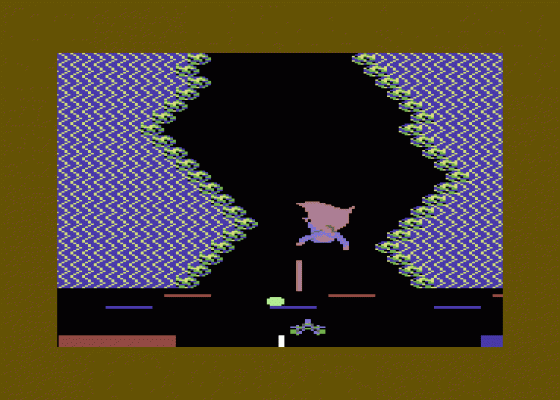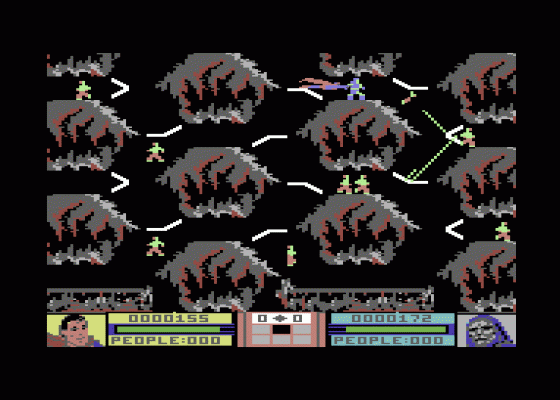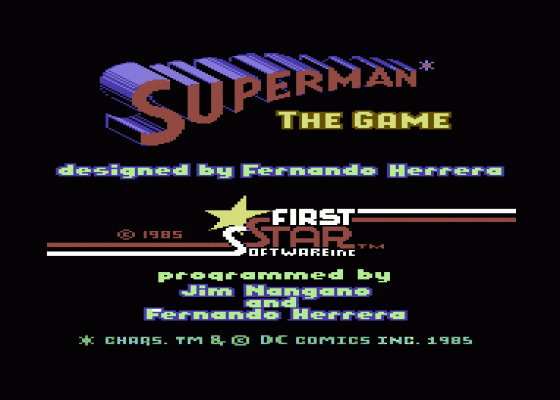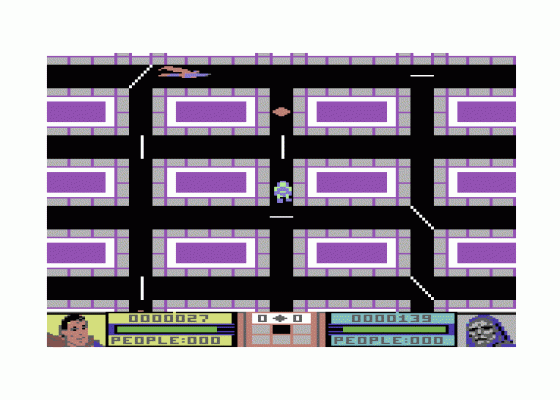
Computer Gamer
 1st January 1986
1st January 1986
Categories: Review: Software
Author: Eric Doyle
Publisher: First Star
Machine: Commodore 64
Published in Computer Gamer #10
Is it a bird? Is it a plane? No, it's Superman: The Game. Eric Doyle dons his cape to investigate the game based on his childhood hero.
Superman
DC Comics' most famous here is here for the Commodore 64. I watch open-mouthed as my childhood hero comes alive on my monitor screen.
This multi-screen game follows the adventures of Superman as he battes to save the citizens of Metropolis from the evil clutches of Darseid and his powerful Omega Beam. Three screens represent the streets of the city and a further three show the underground caverns which lead to Darkseid's dungeon. In addition to this another five screens are reserved for special action games.
As the good citizens wander the streets of Metropolis, Darkseid tries to force them underground into his dungeon mines. Superman tries to guide them to safety using his heat vision whilst avoiding Darkseid's ray. Arranged at street corners and junctions around the city are deflector shields which may be set to reflect either ray. The shields also serve to divert citizens towards the exits leading to safety or the dangers of the subterranean caverns.

If this wasn't enough to keep the two arch enemies busy, there are also dimensioniers (diamond shapes) to be gathered to allow entry to adjoining scenes. To pass from one scene to the next means suffering the delights of the action screens. Compared to the first part of the game, these mini games are relatively undemanding and the game slips into the realms of boredom.
After battling with Darkseid to clear an area of citizens and then fighting to gain enough dimensioniers to allow you to exit towards the next area you want to visit; it is a little disappointing to find that the most boring of the inaction screens is the one which appears most frequently. This one leads to the caverns and the passageway is guarded by a kryptonite launcher. As Superman is guided through the tunnel he must avoid the hail of green boulders and, at the same time, try to hit the launcher with his heat rays. If eight strikes are made on the launcher then Superman emerges on the next screen. If eight boulders hit Superman then he re-emerges on the screen which he was trying to get away from and he must battle against Darkseid and the Omega Ray for dimensioniser superiority once more.
Of the other action screens, the only one which approaches a challenge is a battle against Darkseid's fireball machine. Using his super-breath, our Superhero must blow the fireballs back down each of the eight gun barrels without being hit himself.

Success depends on the speed with which you can move into the path of a boulder and blow without being hit. As the number of fireball tubes decreases the harder this task becomes because the remaining tubes fire more frequently.
Super graphics are used in the screen where Superman must run the gauntlet against Darkseid's laser emplacements on one of Metropolis' streets. This is shown in 3D as our hero flies through the buffetting air currents. This is all reminiscent of Luke Skywalker's battle on the Death Star but without as much excitement.
Darkseid's Destroyer is menacing the city in another scenario. As outsize bombs resembling beachballs fall from the craft, Superman has to punch them out of existence to prevent the destruction of Metropolis.

The final screen is set in one of the cavern passages where Darkseid is chasing Superman. Unbeknown to Darkseid, the super hero has set a few traps for the evil one and as Superman flies along dodging Darkseid's shots he triggers either a force-field or an avalanche of radioactive boulders.
Although the graphics are very good, the complexity of the gameplay often leaves a lot to be desired. After a while I found the action screens to be intrusive and wished that movement between the streets of Metropolis and the caverns was decided by chance instead of the repetitious nuisance screens. Maybe if more programming had gone into the six main screens adding exta problems the game would have appealed to me more but this is mere conjecture. As it stands, the game is not as super as its title would have you believe and it has the feel of a C16 conversion which does not make full use of the C64's extra power.
This last point is not surprising because the game is a C16 game and it will also be the Spectrum, Atari and Amstrad versions. In an effort to standardise the games, the programmers have been told to work on the lowest common denominator - the C16. This obviously holds back what can be done with the game and it therefore leaves a lot to be desired. I must say that if it looks as good on the C16 then it rates as one of the best looking games that I've seen (for the C16!).
Trying the game on the C128 revealed one of the problems of ths machine's 'compatibility'. True compatibility with the 64 is impossible because there are several differences within the range of C64s produced over the years. Occasionally a piece of software shows these differences and in this case the blue parts of Superman's costume were not visible.
One good feature is that the two player game allows your opponent to control Darkseid's actions though in most of the action screens the control is limited in range.
Beyond have bult up a name for quality games but this one dents that reputation in my opinion. If it sells, it will be on a wave of hype surrounding the Superman name in the same way as another rather dull game, based on a ghost film, sold on the strength of excellent voice synthesis.
Other Reviews Of Superman: The Game For The Commodore 64
Superman (Beyond)
A review by Eugene Lacey (Commodore User)








